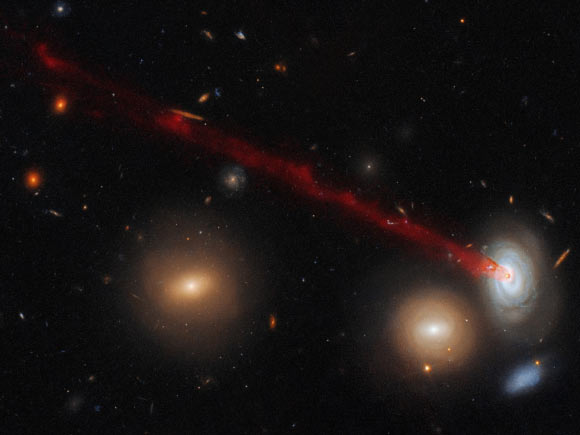A long streamer of hydrogen gas is being stripped from a spiral galaxy called D100 as it plunges toward the center of the Coma cluster (also known as Abell 1656), a large group of galaxies approximately 330 million light-years away in the northern constellation of Coma Berenices. Eventually, D100 will lose all of its gas and become a dead relic, deprived of the material to create new stars and shining only by the feeble glow of old, red stars.

This striking image combines data gathered with Hubble’s Advanced Camera for Surveys (ACS) and data from the Subaru Telescope in Hawaii. It shows just a part of the spectacular tail emerging from the spiral galaxy D100. Image credit: NASA / ESA / Hubble / Cramer et al.
“D100 stands out as a particularly extreme example of processes common in massive clusters, where a galaxy goes from being a healthy spiral full of star formation to a ‘red and dead galaxy’,” said Dr. William Cramer, an astronomer at Yale University.
“The spiral arms disappear, and the galaxy is left with no gas and only old stars. This phenomenon has been known about for several decades, but Hubble provides the best imagery of galaxies undergoing this process.”
This process, called ‘ram-pressure stripping,’ occurs when a galaxy, due to the pull of gravity, falls toward the dense center of a massive cluster of thousands of galaxies, which swarm around like a hive of bees.
During its plunge, the galaxy plows through intergalactic material, like a boat moving through water. The material pushes gas and dust from the galaxy.
Once the galaxy loses all of its hydrogen gas — fuel for starbirth — it meets an untimely death because it can no longer create new stars.
In the massive Coma cluster, this violent gas-loss process occurs in many galaxies.
But D100 is unique. Its long, thin tail, for example, extends nearly 200,000 light-years — about the length of two Milky Way galaxies. In addition, the tail is narrow, only 7,000 light-years wide.
“The tail is remarkably well-defined, straight and smooth, and has clear edges. This is a surprise because a tail like this is not seen in most computer simulations,” said Dr. Jeffrey Kenney, also from Yale University.
“Most galaxies undergoing this process are more of a mess. The clean edges and filamentary structures of the tail suggest that magnetic fields play a prominent role in shaping it. Computer simulations show that magnetic fields form filaments in the tail’s gas. With no magnetic fields, the tail is more clumpy than filamentary.”
The main goal of the astronomers was to study star formation along the tail of D100.
They found that the brightest clump in the middle of the tail contains at least 200,000 stars, triggered by the ongoing gas loss from the galaxy.
The Subaru Telescope observed the glowing tail in 2007 during a survey of the Coma cluster’s galaxies. But the astronomers needed Hubble observations to confirm that the hot hydrogen gas contained in the tail was a signature of star formation.
The new Hubble data show that the gas-stripping process began on D100’s outskirts and is moving in towards the center, which is typical in this type of mass loss.
Based on the Hubble images, the gas has been cleared out all the way down to the central 6,400 light-years.
Within that central region, there is still a lot of gas, as seen in a burst of star formation.
“This region is the only place in the galaxy where gas exists and star formation is taking place. But now that gas is being stripped out of the center, forming the long tail,” Dr. Cramer said.
The findings were published in the Astrophysical Journal.
_____
W.J. Cramer et al. 2019. Spectacular Hubble Space Telescope Observations of the Coma Galaxy D100 and Star Formation in Its Ram Pressure-stripped Tail. ApJ 870, 63; doi: 10.3847/1538-4357/aaefff







